Body and Intention – Tracking Down Musicians’ Health
It is easy to take piano playing and musicianship for granted but most people have experienced physical tension and strain while practicing. The American pianist, pedagogue, and researcher Dr. Kathleen Riley has spent many years developing a method called Optimal Performance, scanning pianists’ bodies using electrodes. In a Masterclass with students and pianist Garrick Ohlsson as test subjects at San Francisco International Piano Festival last fall, we get a chance to see how the method works in action.
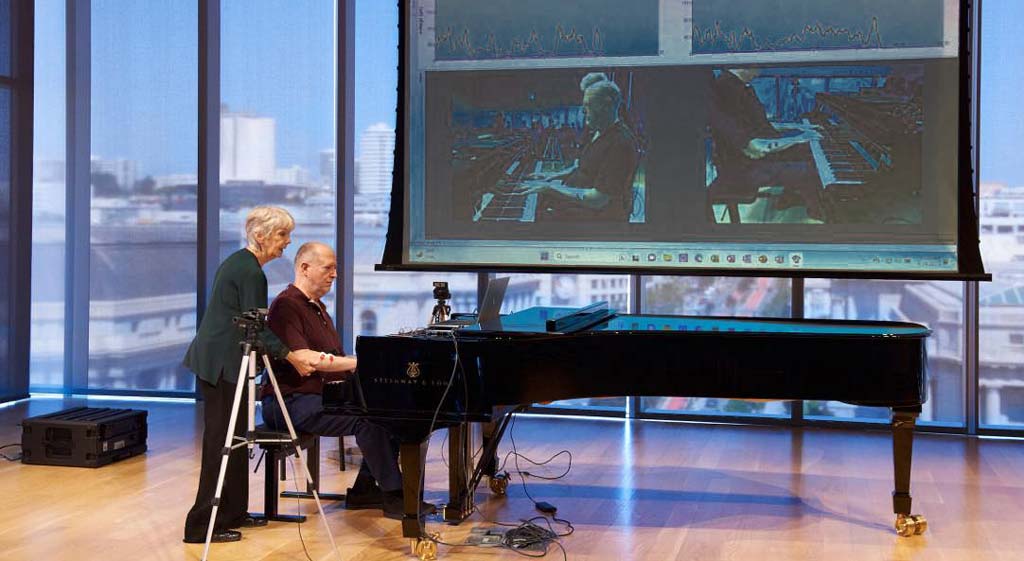
Working towards progress involves many hours with the instrument, and perhaps the piano specifically allows for practice sessions to become long, and even too long. The subject of student and musician health should not be forgotten in the focused work to improve and optimize one’s potential. A body in harmony with intentions is something everyone strives for, but it is not something that can be taken for granted. Increased knowledge about incorrect habits and perceived frustration can only lead to a big step in the right direction.
What is Bio-feedback?
Bio-feedback is a technique that involves using electronic devices to measure and provide feedback on various physiological functions of the body. It is commonly used as a tool for stress reduction, anxiety management, and pain control. The devices used in biofeedback measure bodily functions such as muscle tension, heart rate, breathing rate, and skin temperature. The information collected by the device is then displayed on a screen, which enables the user to see their physiological responses.
The Bio-feedback device provides real-time feedback on muscle tension levels, helping to identify when tension is increasing and learn to consciously relax those muscles. This can lead to a more relaxed playing posture, reduced physical fatigue, and a smoother performance. While Bio-feedback can be helpful for individuals in many fields, including musicians, it is essential to note that every person is unique, and the specific techniques used in biofeedback therapy may vary depending on the individual’s specific needs and goals.
Some specific examples of Bio-feedback techniques that may be helpful for musicians include heart rate variability training, which involves controlling the variability of heart rate to improve relaxation and stress management, and electromyography (EMG) feedback, which focuses on reducing muscle tension to improve performance. It is essential to work with a qualified healthcare professional, such as a licensed psychologist or trained Bio-feedback therapist, to receive appropriate guidance and support in using these techniques safely and effectively.
San Francisco International Piano Festival, August 24, 2023:
Video, Bio-feedback Masterclass
Riley on Bio-feedback and HeartMath
We are excited to learn about the functionality of Bio-feedback for pianists and it is thrilling to have the opportunity to watch the entire Masterclass on video. We are also appreciative of the opportunity to directly engage with Dr. Kathleen Riley by asking questions and receiving comments pertaining to this event.
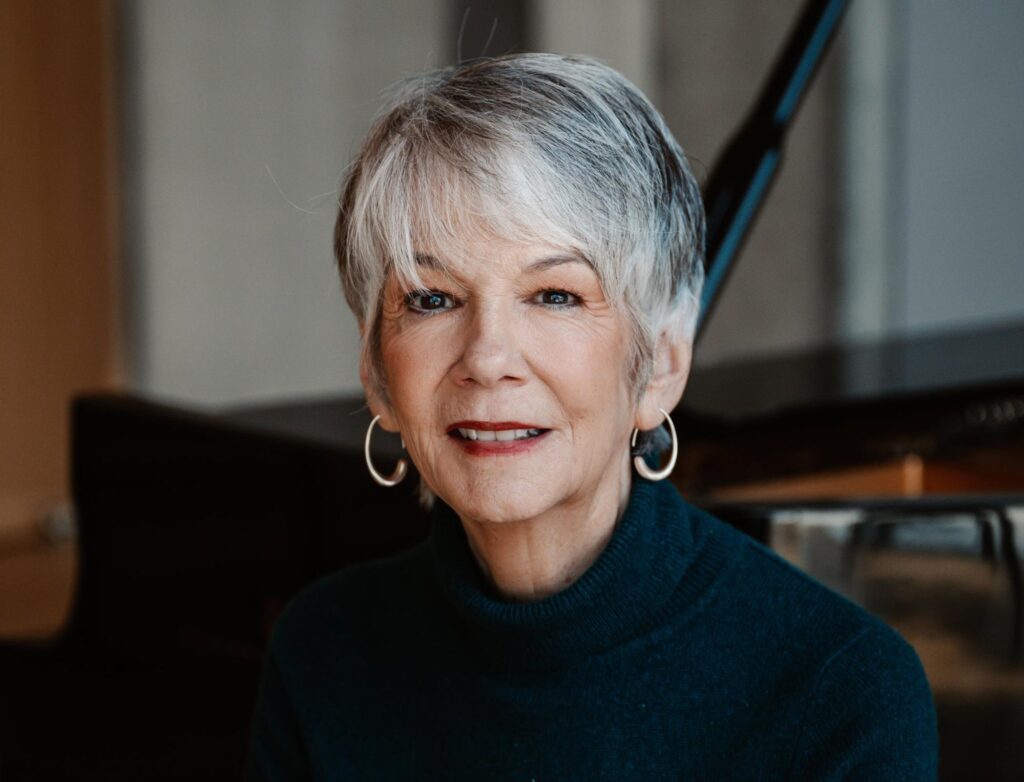 Patrick Jovell: Your Bio-feedback research, Masterclasses and coaching programs are widely recognized and appreciated. By attaching surface electrodes to a musician to measure muscle activity, it’s easy for a master class audience to see how the musician physically interacts with the instrument. In addition to this, you work with another technique, HeartMath, saying it all comes from the heart, and that breathing has a role in this. What can you tell us about HeartMath®?
Patrick Jovell: Your Bio-feedback research, Masterclasses and coaching programs are widely recognized and appreciated. By attaching surface electrodes to a musician to measure muscle activity, it’s easy for a master class audience to see how the musician physically interacts with the instrument. In addition to this, you work with another technique, HeartMath, saying it all comes from the heart, and that breathing has a role in this. What can you tell us about HeartMath®?
Dr. Kathleen Riley: The Institute of HeartMath was founded in 1991. It is a research center that focuses on the intelligence of the heart and the effects of the heart’s electromagnetic field. I have three certifications from HeartMath and have been incorporating it in my teaching, coaching and research. I conducted a pilot study in collaboration with them in 2018 on the effects of a shared intention among members of a string quartet on themselves and audience members. It was filmed as a short documentary that is available on their Research Video Gallery. Here is the link to the trailer, blog and access to the documentary.
Our thoughts and emotions are the drivers of our physiology, including our technical output! Worry and anxiety cause an immediate tightening or bracing in the body. For pianists, this often occurs in the neck and shoulders, elbow, forearm, and/or wrist. Think of these bracings as roadblocks. They disrupt the flow of muscle and fine motor control. There is so much more to say about the psychophysiology of this, but that is for another time.
Intention from the heart is key. It sets the tone within, physically, mentally, emotionally and spiritually. HeartMath’s Heart Focused Breathing™ technique sets the tone: 1) Begin to breathe a little slower and deeper than usual. 2) Begin to focus on the heart area in the center of your chest. Imagine your breath flowing in and out through the heart. 3) Next, draw in a feeling of appreciation or gratitude for someone or something in your life, or about your music.
A simple way to express this, even though there is more to it, is that when we allow feelings of gratitude, love and appreciation to guide our performances, we are able to be in the moment with our music. The music plays us. In harmony, we cocreate the music with our instrument. Harmony demands ebb and flow of tension and release, always accompanied by the breath.
PS: In your Masterclass from San Francisco Conservatory of Music we can, very conveniently, see the pianists’ physical responses graphically on the screen over the piano. Noticeable was the very low activity while pianist Garrick Ohlsson was playing as opposed to the students in general. Which information does these graphic lines provide and how do you communicate the results with the subject/student/musician?
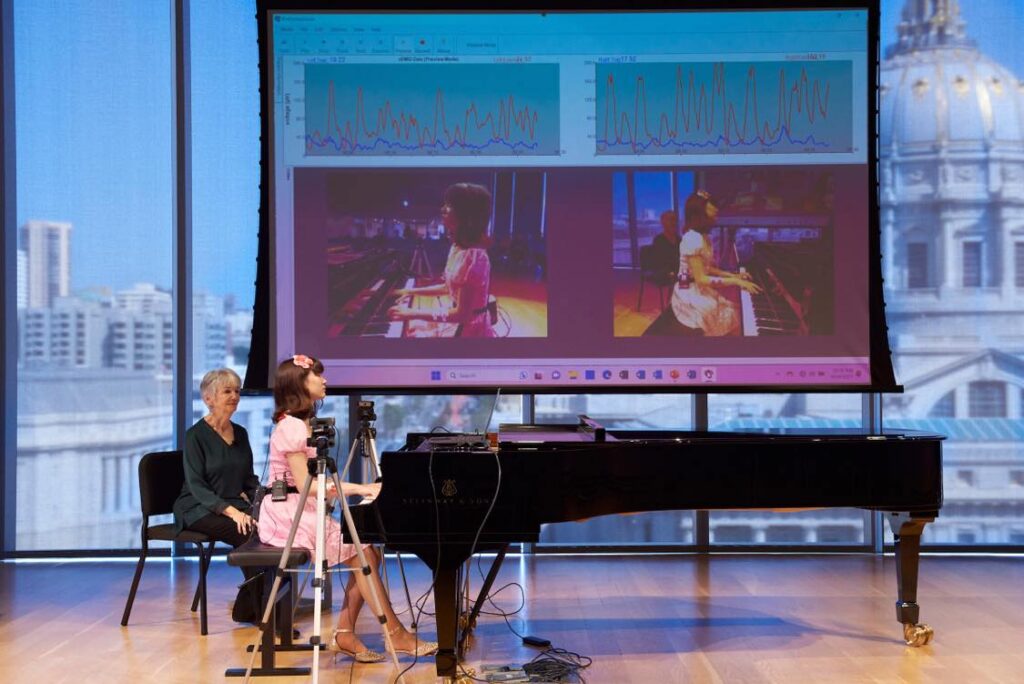
KR: By placing surface electrodes on a musician’s forearms and top of shoulders, I monitor muscle activity. Seeing this on the screen along with video camera windows showing the posture of the body, arm and hands in a master class, allows the musician themselves and the audience to see how the body interacts physically with the piano in creating sound.
We expect to see the lines representing the muscles in the graphs on the screen go up as a passage is played. However, it is equally important to see these lines return to baseline (near the bottom of the window) as often as possible. This drop represents what we would term the “follow through” in tennis, where, after serving the ball, the muscles release enough for the arm to move through, relaxing enough to immediately respond to and return the oncoming ball. For pianists, this movement is necessary for the technical choreography of the phrasing. Too much muscle tension inhibits movement and execution.
The first young student participating in my Masterclass exhibited very high muscle tension in both forearms as can be seen in the photo above (photo1) (red lines in upper left and right graphs on the screen, representing left and right forearms) during the opening two pages of the Chopin Ballade Opus 47. This was due to tightness in her shoulders and elbows, and collapsed main knuckles in the bridge of the hand. The muscles inside the hand have not been developed properly. Her shoulder tension, represented by the blue lines in the graphs, is high also. The posture seen in the photo shows the tightness of the upper body. She also does not have well developed upper body muscles.
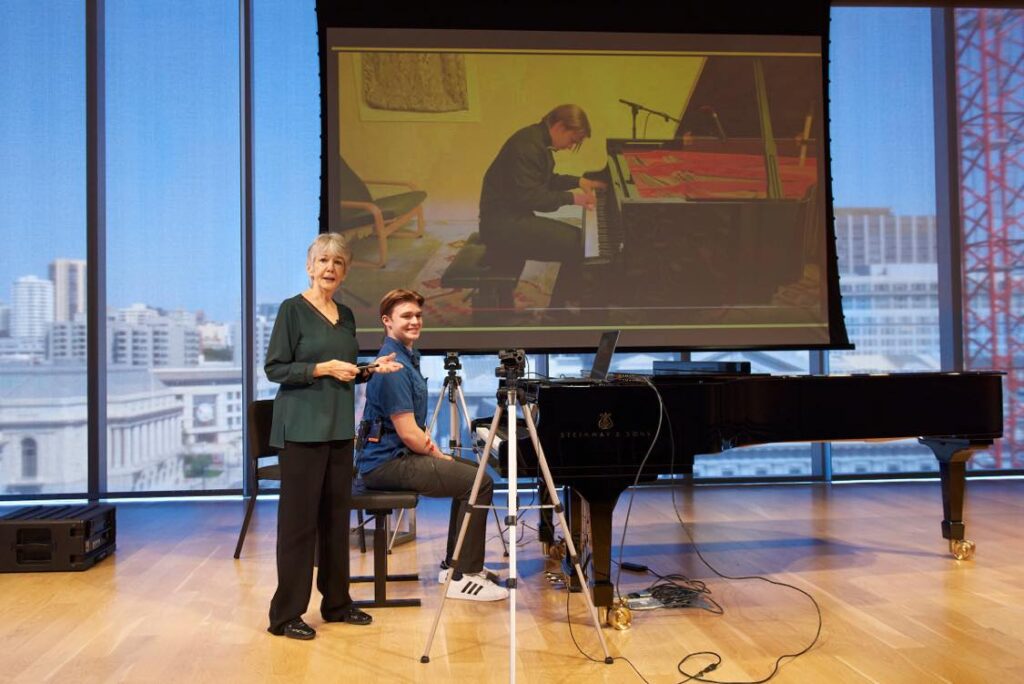
The second student (photo2, above) who participated is recovering from overuse injury and neuropathy. He performed a very simple piece, MacDowell’s to A Wild Rose. He had not been able to play for several months. The first photo, on the screen, shown of him was taken from his audition videos. You can see the poor posture, and tension in the jaw, neck, and back, and collapsed bridge in the hand. Working with him online for a month, I was able to correct his posture and give him some exercises to practice with everyday movements, away from the piano. The result was that he could then play this piece. During the Masterclass, the lines on the screen show very low muscle firing and excellent tension release and the video windows show his excellent posture. Quite a contrast! He reported having no symptoms of neuropathy during the performance.
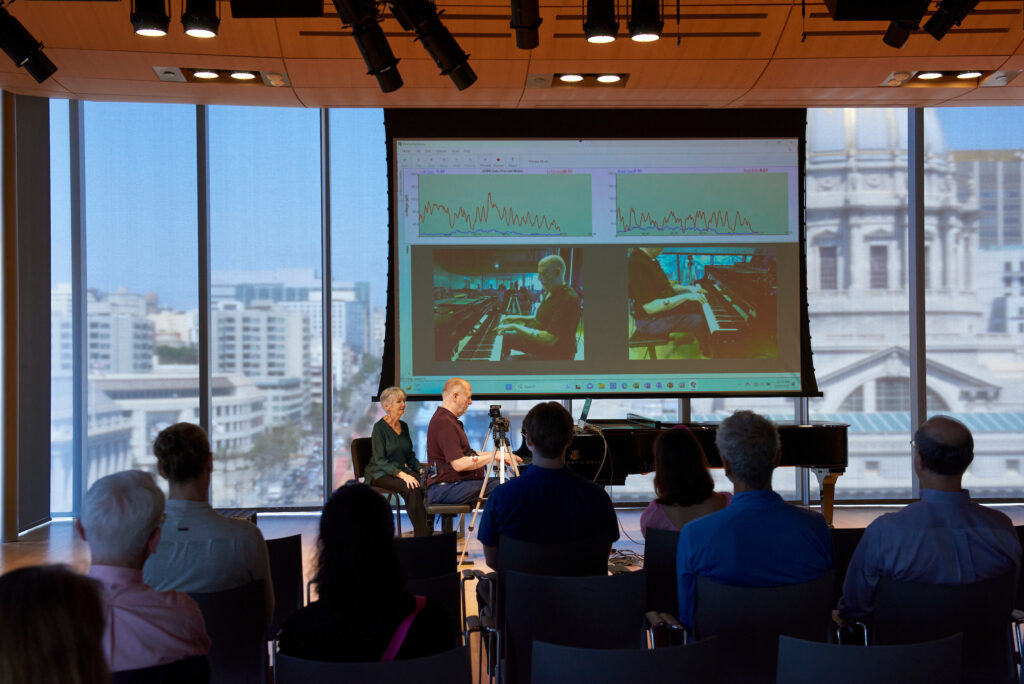
Garrick Ohlsson’s performance of the Chopin Nocturne Opus 15 No. 1 was a beautiful illustration of necessary muscle firing with moments of tension release throughout as indicated by the dips in the red lines in both the left and right graphs. His posture is excellent. He shared with the audience that, because of his height, the bench must be low enough for his knees to rest just under the piano in order to reach the pedals. He is very aware of his body and continually strives to optimize tension release.
PS: Less and less money are invested in musician students’ health issues at conservatories worldwide. Why is it so, and can we see the same tendency at other institutions such as professional ensembles and symphony orchestras as well?
KR: Well, I can say that at most conservatories in the United States there is information about musicians’ neuromuscular, vocal, hearing and mental health available thanks to the efforts of the Performing Arts Medicine Association. Many schools offer a class in either Alexander Technique or Feldenkrais. Some have physical therapists that they refer students to.
However, the issues of misuse and overuse injuries as well as performance anxiety are not addressed adequately. During my years in Cleveland Ohio, I taught courses in Optimal Performance at the Cleveland Institute of Music and ran a Biofeedback lab equipped with ProformaVision sEMG/video biofeedback and HeartMath heart rate variability biofeedback. The students in my classes signed out the lab several times a week and worked on themselves in addition to my teaching and coaching.
The President at the time, Joel Smirnoff, also had me do assessments on every incoming student. By doing this I was able to catch many “red flags” – signs of misuse, overuse, and hear stories of previous sprains or injuries students had forgotten about that were causing improper muscle firing. From there, I referred them to specialists at the Cleveland Clinic, and they enrolled in my classes. I had full compliancy from the Deans and Faculty. The students were grateful.
Then, in the Fall of 2016, the leadership of the Institute had changed. It was a stress filled environment and I sensed that my courses would not expand in the direction that had been discussed. I left after the Spring 2017 semester. Nothing has replaced what I did since then!
I can’t speak to all other institutions, as I know some of the leading orchestras do travel with a doctor, physical therapist and a couple of massage therapists. However, talking with the musicians themselves they report that the schedule is grueling, between travel, hotel check-ins, rehearsals and performances. They return home exhausted and depleted.
My theory as to why more money is invested in this boils down to competition, the motto of having to win, being the best. And for ensembles and symphonies it’s about filling the hall concert after concert so they can exist. But, another problem, perhaps bigger in my opinion in relation to music’s purpose, is that most of this caters to the elite, the privileged percent that can afford to attend the concerts.
As for conservatory education, I believe it needs to come back to addressing the essential ingredient of love – love of music, love of playing, love of sharing music, love of learning. I have heard over the years from hundreds of conservatory students how they felt stress the moment they began their studies; feelings of overwhelm; problems with overuse injuries; fear of making mistakes and not “being good enough.”
Yet this demands some significant changes to the schedules and the curriculum. If our mission is to teach music and to inspire students to carry it with them through their lives, we must look at the broader perspective. It’s simply not all about winning the competitions and having solo careers. Connecting our students with a sense of heartfelt purpose through sharing their music is key. Hopefully, they will listen.
Read more:
20 years ago – Article from New York Times on Riley’s pioneering work
Article on Bio-feedback measurement and evaluation (2005)
Starting working with pianist Garrick Ohlsson (2010)
Do You Sound Like You Think You Do? Article on Sonification and Analysis (2022)
A student’s perspective on Bio-feedback (2023)
Article on The Interface of Piano Pedagogy with The Medical Community from MTNA e-Journal
Photo credits
Portrait: Jiyang Chen
Session photos: Stefan Cohen
Comments
I have not seen the whole masterclass, but I wonder if the Taubman technique has been mentioned/considered. Dorothy Taubman developed a specificpiano technique based on the science of motion, and trained many pianists to avoid or correct injury with her teaching. Edna Golandsky has continued her work. Here is a link to the Golandsky Institute.
https://www.golandskyinstitute.org/. It is well worth exploring in the context of this research.
Hi, I have a question for “PS”: Where did you learn that “Less and less money are invested in musician students’ health issues at conservatories worldwide.”? Could you share the source, please. Thank you
Pavel